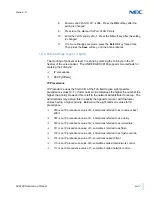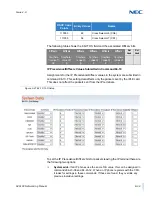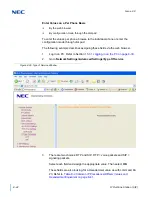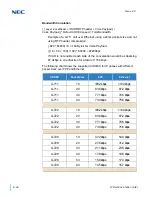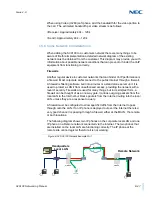
Issue 2.0
SV9100 Networking Manual
8-47
When using Video (H.263) soft phone, add the bandwidth for the video portion to
the call. The estimated bandwidth per video stream is as follows:
<Receive> Approximately 40k ~ 120k
<Send> Approximately 40k ~ 120k
15.6 Some Network Considerations
When adding the SV9100 to a customers network there are many things to be
aware of. Before implementation a detailed network diagram of the existing
network must be obtained from the customer. This diagram may provide you with
information about possible network conditions that can prevent or hinder the VoIP
equipment from functioning correctly.
Firewalls
Another regular device in customer networks that can hinder VoIP performance is
a firewall. Most corporate LANs connect to the public Internet through a firewall.
A firewall is filtering software built into a router or a stand alone server unit. It is
used to protect a LAN it from unauthorized access, providing the network with a
level of security. Firewalls are used for many things, but in its simplest form, a
firewall can be thought of as a one way gate. It allows outgoing packets from the
local LAN to the Internet but blocks packets from the Internet routing into the local
LAN, unless they are a response to query.
A firewall must be configured to allow specific traffic from the Internet to pass
through onto the LAN. If an IP phone is deployed out over the Internet there is a
very good chance it is passing through a firewall, either at the MAIN , the remote,
or both locations.
The following diagram shows two IP phones on the corporate local LAN and one
IP phone on a Remote network connected via the Internet. The two phones that
are installed on the local LAN are functioning correctly. The IP phone at the
remote site cannot register therefore it is not working.
Figure 8-32 SV9100 Network Example No. 1
Internet
Headquarters
Local LAN
Remote Network
Firewall
Firewall
Summary of Contents for Univerge SV9100
Page 1: ...Networking Manual A50 035910 004 AU Issue 2 0...
Page 20: ...xviii Table of Contents Issue 2 0...
Page 26: ...xxiv List of Figures Issue 2 0...
Page 33: ...Book 1 SV9100 K CCIS...
Page 49: ...Issue 2 0 1 16 General Information US Only Figure 1 15 Circuit Identification Codes CIC...
Page 53: ...Issue 2 0 1 20 General Information US Only...
Page 61: ...Issue 2 0 2 8 Hardware Installation US Only...
Page 195: ...Issue 2 0 4 116 Features and Specifications...
Page 242: ...Book 2 SV9100 IP Networking...
Page 256: ...Issue 2 0 2 12 IP Networking...
Page 312: ...Issue 2 0 4 48 Programming...
Page 376: ...Issue 2 0 6 30 SIP Trunking...
Page 391: ...Issue 2 0 7 14 H 323 Trunking...
Page 467: ...Issue 2 0 8 76 IP Multiline Station SIP...
Page 551: ...Issue 2 0 10 64 SV9100 NetLink Conditions None Feature Cross Reference None...
Page 567: ...Issue 2 0 10 80 SV9100 NetLink Conditions None Feature Cross Reference None...
Page 579: ...Issue 2 0 11 6 NAPT...
Page 580: ...Issue 2 0 SV9100 Networking Manual 11 7...
Page 581: ...Issue 2 0 11 8 NAPT...
Page 582: ...Issue 2 0 SV9100 Networking Manual 11 9...
Page 583: ...Issue 2 0 11 10 NAPT...
Page 584: ...Issue 2 0 SV9100 Networking Manual 11 11...
Page 595: ...Issue 2 0 12 4 All DSP Busy Indication...
Page 671: ...Issue 2 0 13 76 AspireNet Conditions None Feature Cross Reference None...
Page 685: ...Issue 2 0 13 90 AspireNet Department Calling Flexible System Numbering Intercom...
Page 707: ...Issue 2 0 13 112 AspireNet Default Trunk Port Number Name 1 Line 001 2 Line 002 400 Line 400...
Page 713: ...Issue 2 0 13 118 AspireNet Department Calling...
Page 765: ...Issue 2 0 13 170 AspireNet...





